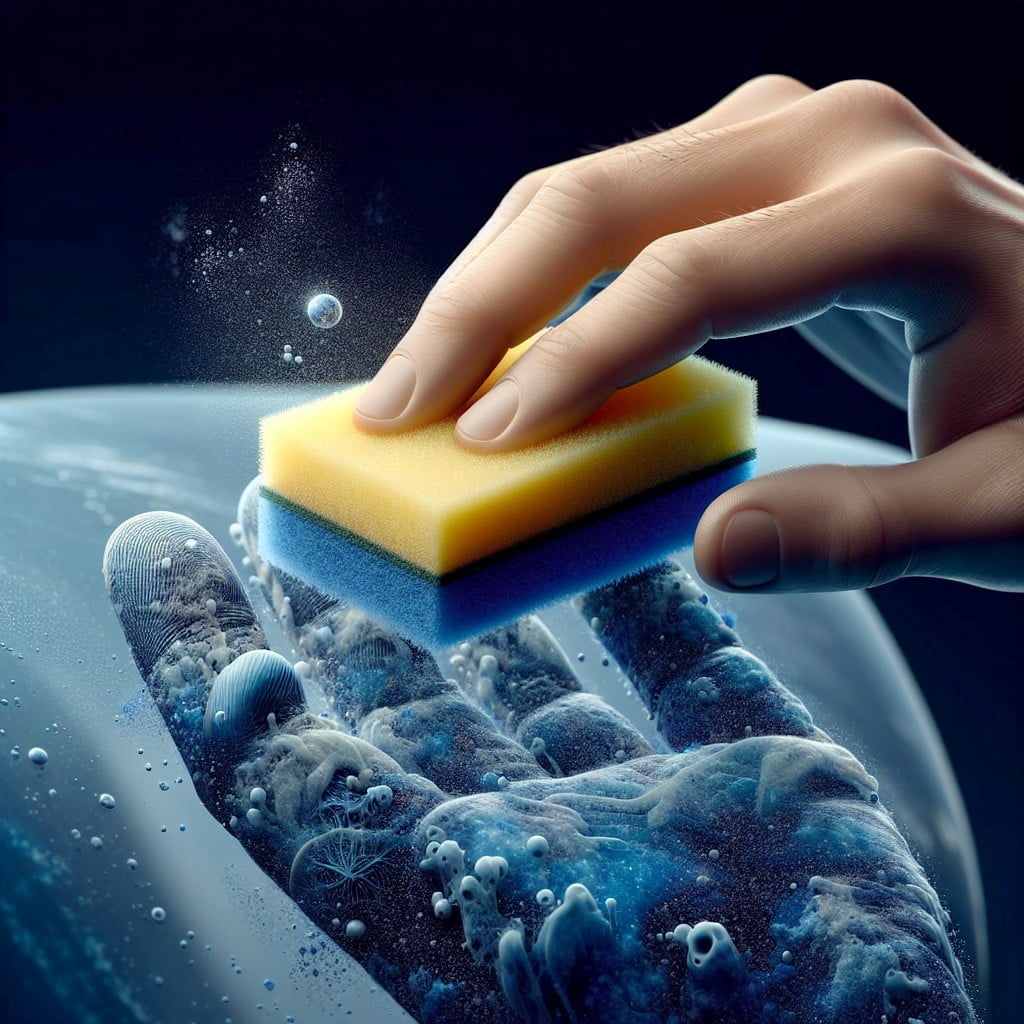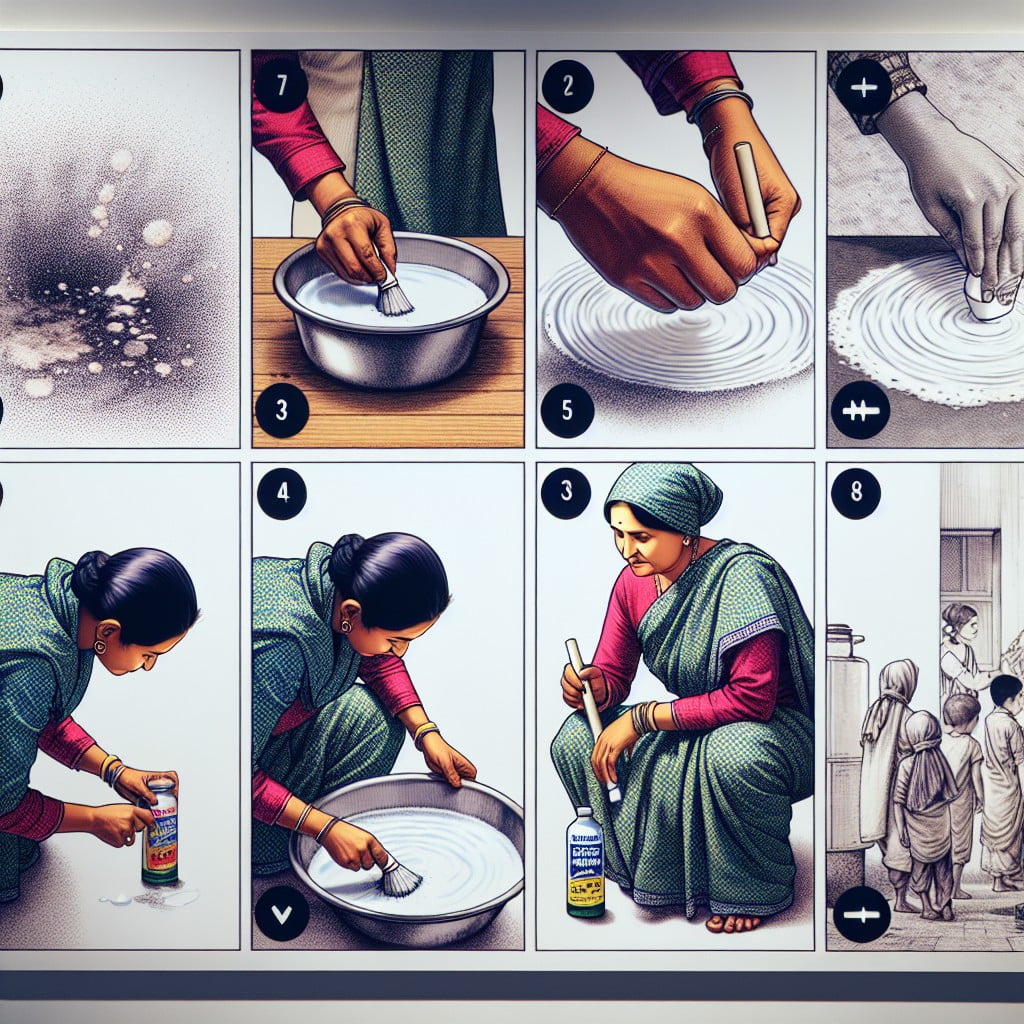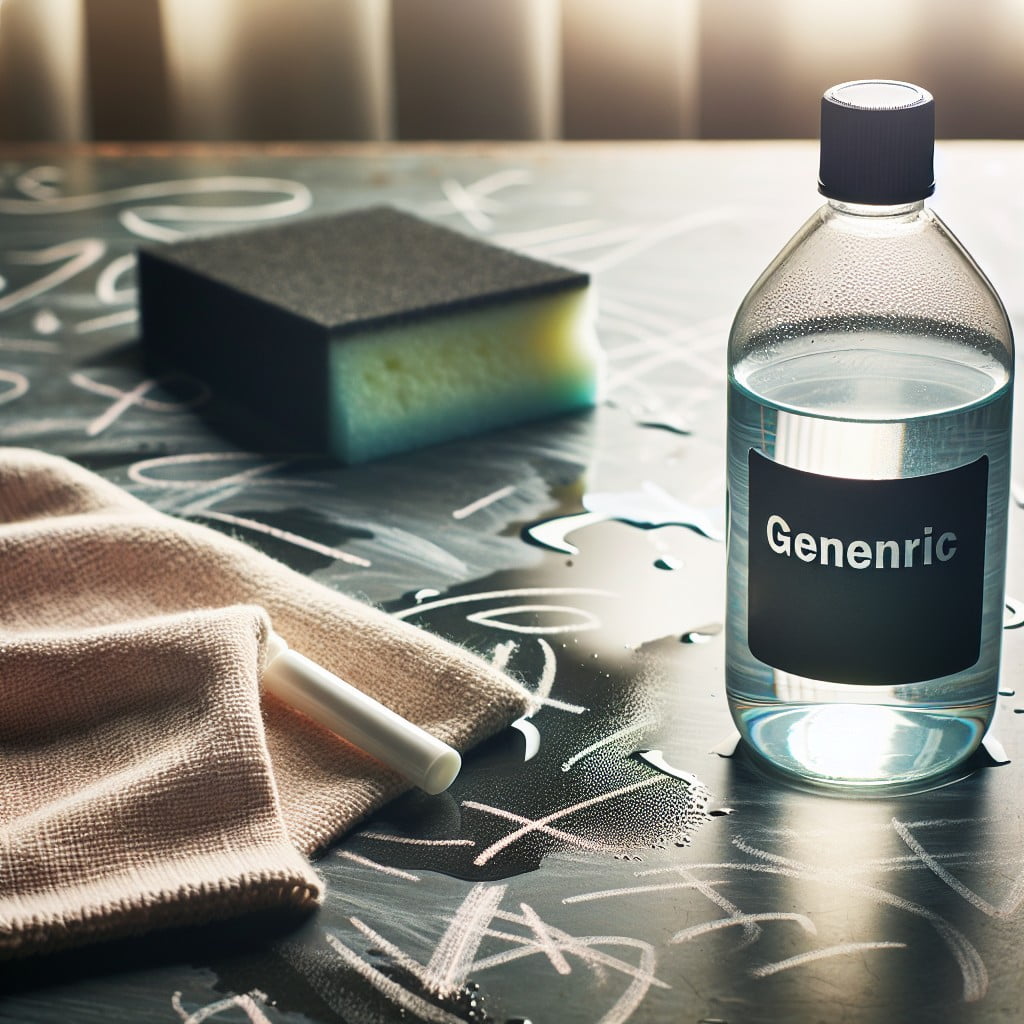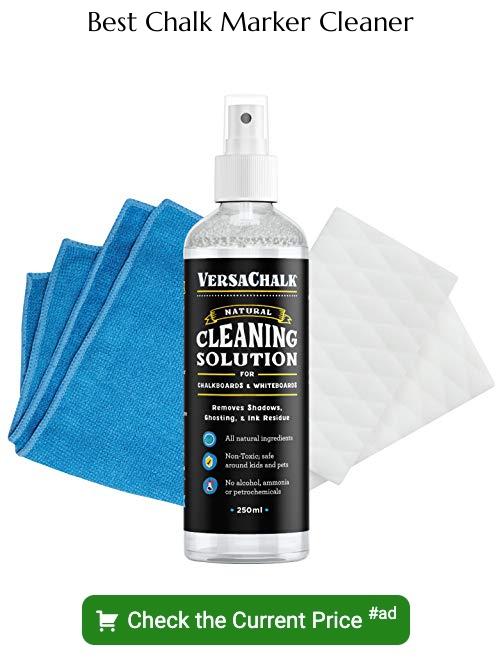Last updated on
Unlocking the secret to effectively remove chalk marker stains becomes essential because, over time, these seemingly innocent art tools can mar your beautiful surfaces.
Key takeaways:
- Magic Eraser: Dampen sponge, gently rub in circular motion
- Water and Vinegar Solution: Mix, apply, let sit, rub, rinse, dry
- Comet Cleaner With Water: Create paste, scrub gently, rinse
- Glass Cleaner: Spray, let sit, wipe, repeat if necessary
- Isopropyl Rubbing Alcohol: Moisten cloth, rub gently, test first
Magic Eraser

A Magic Eraser can effectively remove chalk marker ink, especially from non-porous surfaces like glass or laminated countertops. Comprised of melamine foam, this tool works like ultra-fine sandpaper to lift away stubborn residues.
Before use, dampen the sponge and gently rub over the marked area in a circular motion. As the foam disintegrates, it lifts the pigment from the surface. Test the eraser on a small, inconspicuous area first to ensure it doesn’t damage the finish.
Keep in mind that overuse might result in dulling of shinier surfaces, so use with care. Rinse the surface with water after cleaning to remove any remaining residue.
Water and Vinegar Solution

A homemade solution of water and vinegar offers an effective and eco-friendly way to remove chalk marker residue. The acidity of vinegar breaks down the marker’s pigments, making it easier to wipe away.
Here’s how to use this method:
- Mix equal parts of white vinegar and water in a bowl or spray bottle.
- Apply the solution to the marked area, covering it thoroughly.
- Let it sit for a few minutes; this dwell time allows the vinegar to penetrate and loosen the chalk particles.
- Use a soft cloth or paper towel to gently rub the surface in a circular motion. For stubborn marks, a bit more elbow grease may be required.
- Rinse with fresh water to remove any lingering vinegar solution.
- Dry the surface completely with a clean towel or allow it to air dry.
Always spot-test in an inconspicuous area first, especially on painted or varnished surfaces, to ensure the vinegar won’t cause damage.
Comet Cleaner With Water

When dealing with stubborn chalk marker residue, a blend of Comet cleaner and water can be highly effective.
Create a paste by mixing a small amount of the powdered cleanser with water until it reaches a paste-like consistency.
Apply this mixture directly onto the stained area with a soft cloth or sponge, using a circular motion to gently scrub the surface.
The mild abrasives in the Comet cleaner will assist in lifting the ink without damaging the underlying surface.
It’s important to rinse the area thoroughly with water after cleaning to remove any leftover cleaning agents.
For surfaces that may be sensitive to abrasives, such as painted chalkboards, it’s advisable to perform a spot test in an inconspicuous area before full application.
This ensures that the cleaning method does not harm the finish of your chalkboard or surface.
Glass Cleaner

For non-porous surfaces like mirrors or windows, a glass cleaner can be particularly effective. The ammonia in the cleaner breaks down the chalk marker’s pigments and adhesives, making it easier to wipe away. To use it:
- 1. Spray the glass cleaner liberally over the marked area.
- 2. Allow it to sit for a minute to dissolve the chalk marker.
- 3. Wipe the surface clean with a soft cloth or paper towel.
- 4. Repeat if necessary, ensuring all traces of the marker are gone.
For added efficiency, a microfiber cloth can enhance the removal process due to its fine fibers, which can lift and hold the marker residue more effectively than a regular cloth. Always perform a spot test in an inconspicuous area first to ensure the cleaner does not damage or discolor the surface.
Remember to work in a well-ventilated area when using glass cleaner as the fumes can be strong, and avoid contact with your skin or eyes.
Isopropyl Rubbing Alcohol
For stubborn chalk marker residues, isopropyl rubbing alcohol can work wonders. This solution, often found in first aid kits, breaks down the oily components in the markers, allowing for easier removal.
To use, moisten a cloth or cotton ball with the alcohol and gently rub it over the stained area. The alcohol evaporates quickly, so there’s no need for a rigorous scrubbing motion.
Keep in mind that it’s advisable to test a small inconspicuous area first to ensure the alcohol doesn’t damage the surface. Also, provide adequate ventilation while using alcohol-based products, as the fumes can be strong.
Chalkboard-Specific Cleaner
Manufacturers often produce specialized cleaners designed to work effectively on chalkboards without damaging them. These products are formulated to dissolve chalk marker residue while preserving the chalkboard surface.
- Appropriate formulas: These cleaners often have a non-abrasive formula that cleans without scratching the chalkboard.
- Effective use: Spray a small amount onto the chalkboard, and use a soft cloth to gently wipe away the marks.
- For persistent stains, let the cleaner sit for a few minutes before wiping.
- Advantages: In addition to removing chalk, these products typically condition the surface, making future cleanings easier and improving chalk adherence.
- Eco-friendly options: Environmentally conscious users can find eco-friendly alternatives that do not contain harmful chemicals.
Always check the compatibility of the cleaner with your specific type of chalkboard, and follow the instructions provided by the manufacturer for the best results.
Seasoning the Chalkboard After Cleaning
Once your chalkboard is spotless, it’s important to ‘season’ it to ensure an easy clean-up in the future. Seasoning creates a protective layer that prevents chalk marker pigments from seeping into the board’s surface.
To season:
- 1. Take a piece of regular white chalk and hold it on its side.
- 2. Cover the entire surface in a thin layer of chalk.
- 3. Use a felt eraser or dry cloth to rub the chalk into the board, creating a uniformly dusty layer.
- 4. Wipe the board with a dry cloth to remove excess chalk.
This process provides a seasoned layer that will make future chalk art or pen marks easier to remove and maintain the longevity and effectiveness of your cleaned chalkboard.
Prevention: Tips for Easy Removal
To minimize the struggle of removing chalk marker residue, apply these preventative measures:
- Prime your chalkboard before first use by rubbing the side of a chalk stick over the entire surface and then erasing it. This creates a protective layer that can facilitate subsequent cleanings.
- Opt for high-quality, water-based chalk markers as they’re designed for easier removal.
- Test the chalk marker on a small area of your surface, particularly if it’s porous, to ensure it can be wiped off cleanly.
- After writing, don’t let the chalk marker ink sit for too long; erase your designs and notes regularly to prevent the pigment from setting in.
- Consider using a sealant on porous surfaces where you frequently use chalk markers, making future cleaning attempts less laborious.
Understanding Porous Vs. Non-Porous Surfaces
When tackling chalk marker stains, it’s crucial to recognize whether you’re dealing with a porous or non-porous surface, as this will dictate your cleaning strategy.
Porous surfaces, like untreated wood, paper, and certain types of unsealed chalkboards, have tiny holes that absorb liquids and pigments. This quality makes stains on these materials more stubborn, often requiring gentler, repeated treatments to avoid damage.
On the other hand, non-porous surfaces, such as glass, metal, or sealed chalkboards, feature a smooth, impenetrable finish. Stains sit on the surface, making them easier to remove with stronger solvents and less elbow grease. Identifying your surface type is the first step to effectively removing chalk marker residue.
Choosing the Right Cleaning Solution
When selecting a cleaning solution for removing chalk marker, it’s important to consider the surface you are dealing with. Non-porous materials, like glass or metal, typically release chalk marker with ease and can handle a variety of cleaners including glass cleaners or a simple solution of soap and water. For stubborn marks, isopropyl rubbing alcohol can be effective.
If you’re working with a porous surface, like certain types of chalkboards or painted walls, extra care is required to avoid damaging the material. A water and vinegar mixture (1:1 ratio) can gently dissolve the ink without harming the surface. For more challenging stains, a chalkboard-specific cleaner is advisable as they are formulated to be gentle on delicate surfaces.
Always test your chosen solution on a small, inconspicuous area first to ensure there’s no damage or discoloration. If you’re in doubt, consulting the manufacturer’s recommendations can guide you toward the best cleaning method for your specific surface. Remember, the goal is to remove the marker without leaving a trace behind.
FAQ
What removes chalk marker best?
The most effective method to remove chalk marker is to use a solution combining 70% water and 30% vinegar, or alternatively, a Mr. Clean Magic Eraser can also be employed.
Is chalk marker removable?
Yes, chalk marker is removable, especially from non-porous surfaces like glass and metal, typically with the aid of a clean, damp cloth or soaking the surface with water for a few minutes.
How do you get chalk marker off a chalkboard without magic eraser?
To effectively remove chalk marker from a chalkboard without the use of a magic eraser, the initial step involves employing dish soap mixed with water and a paper towel, and if unsatisfactory results are obtained, a glass cleaner can be applied for more comprehensive ink removal.
Can vinegar be utilized to remove chalk marker?
Yes, vinegar is effective for removing chalk marker due to its acidic nature which breaks down the chemicals in the chalk.
What are the effective store-bought solutions for chalk marker removal?
Effective store-bought solutions for chalk marker removal include Magic Eraser cleaning pads, Windex glass cleaner, and vinegar-based cleaning agents.
Does wiping with a damp cloth effectively remove chalk marker from non-porous surfaces?
Yes, wiping with a damp cloth effectively removes chalk marker from non-porous surfaces.
Recap:





